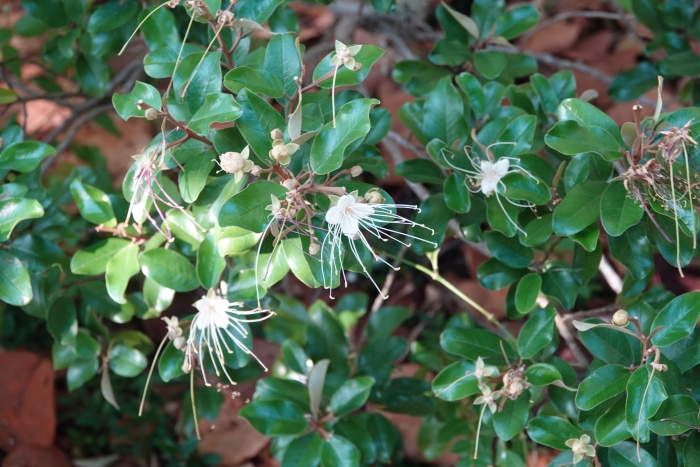Jamaican Caper
(Capparis cynophallophora)
Jamaican Caper (Capparis cynophallophora)
/
/

Claire Herzog
CC BY 4.0
Image By:
Claire Herzog
Recorded By:
Copyright:
CC BY 4.0
Copyright Notice:
Photo by: Claire Herzog | License Type: CC BY 4.0 | License URL: http://creativecommons.org/licenses/by/4.0/ | Rights Holder: Claire Herzog | Publisher: iNaturalist | Date Created: 2020-05-13T08:52:28-07:00 |


















Estimated Native Range
Summary
Capparis cynophallophora, commonly known as Jamaican Caper, is a small evergreen tree native to tropical hardwood forests, coastal woodlands, and rocky areas of the Caribbean, Florida, Mexico, and Central America. It typically grows to a height of 15-25 feet (4.5-7.6 meters) with a similar spread, featuring a dense, rounded canopy. The new leaves at the apical tips of twigs are folded in half, displaying only the whitish, hairy abaxial (lower or ventral) side. As they mature, the leaves unfold to reveal a glossy, dark green adaxial (upper or dorsal) surface. Jamaican Caper produces showy pink and purple flowers in the spring, which are followed by elongated fruits that split open to release several large, brown seeds.
Jamaican Caper is valued for its ornamental foliage, attractive bark, and its tolerance to a variety of growing conditions, making it suitable for urban planting, as a specimen tree, or for use in hedges and screens. It is drought-tolerant once established and can adapt to a range of soil types, though it prefers well-drained soils. This species is also salt-tolerant, making it a good choice for coastal areas. Gardeners should be aware that while it is not typically prone to serious pests or diseases, it can be sensitive to root rot in poorly drained soils.CC BY-SA 4.0
Jamaican Caper is valued for its ornamental foliage, attractive bark, and its tolerance to a variety of growing conditions, making it suitable for urban planting, as a specimen tree, or for use in hedges and screens. It is drought-tolerant once established and can adapt to a range of soil types, though it prefers well-drained soils. This species is also salt-tolerant, making it a good choice for coastal areas. Gardeners should be aware that while it is not typically prone to serious pests or diseases, it can be sensitive to root rot in poorly drained soils.CC BY-SA 4.0
Plant Description
- Plant Type: Tree, Shrub
- Height: 10-15 feet
- Width: 6-15 feet
- Growth Rate: Moderate
- Flower Color: Cream, White
- Flowering Season: Spring
- Leaf Retention: Evergreen
Growth Requirements
- Sun: Full Sun, Part Shade
- Water: Medium, Low
- Drainage: Medium, Fast
Common Uses
Bee Garden, Bird Garden, Butterfly Garden, Drought Tolerant, Low Maintenance, Potted Plant, Showy Flowers
Natural Habitat
native to tropical hardwood forests, coastal woodlands, and rocky areas of the Caribbean, Florida, Mexico, and Central America
Other Names
Common Names: Jamaican Caper
Scientific Names: , Capparis cynophallophora, Quadrella jamaicensis, Quadrella cynophallophora, Capparis jamaicensis, Capparis cynophallophora var. pubescens, Quadrella siliquosa, Capparis cynophallophora var. puberula, Capparis longifolia, Capparis cynophallophora f. angustifolia
GBIF Accepted Name: Quadrella cynophallophora (L.) Hutch.